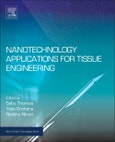Tissue engineering involves seeding of cells on bio-mimicked scaffolds providing adhesive surfaces. Researchers though face a range of problems in generating tissue which can be circumvented by employing nanotechnology. It provides substrates for cell adhesion and proliferation and agents for cell growth and can be used to create nanostructures and nanoparticles to aid the engineering of different types of tissue. Written by renowned scientists from academia and industry, this book covers the recent developments, trends and innovations in the application of nanotechnologies in tissue engineering and regenerative medicine. It provides information on methodologies for designing and using biomaterials to regenerate tissue, on novel nano-textured surface features of materials (nano-structured polymers and metals e.g.) as well as on theranostics, immunology and nano-toxicology aspects. In the book also explained are fabrication techniques for production of scaffolds to a series of tissue-specific applications of scaffolds in tissue engineering for specific biomaterials and several types of tissue (such as skin bone, cartilage, vascular, cardiac, bladder and brain tissue). Furthermore, developments in nano drug delivery, gene therapy and cancer nanotechonology are described. The book helps readers to gain a working knowledge about the nanotechnology aspects of tissue engineering and will be of great use to those involved in building specific tissue substitutes in reaching their objective in a more efficient way. It is aimed for R&D and academic scientists, lab engineers, lecturers and PhD students engaged in the fields of tissue engineering or more generally regenerative medicine, nanomedicine, medical devices, nanofabrication, biofabrication, nano- and biomaterials and biomedical engineering.
Please Note: This is an On Demand product, delivery may take up to 11 working days after payment has been received.
Table of Contents
1. Nanomedicine and Tissue Engineering 2. Design of biomaterials using nanotechnlogy 3. Electrospinning of polymers for tissue engineering. 4. Biomimetic nanofibers for muskuloskeletal tissue engineering 5. Hydrogels Promising candidates for tissue engineering 6. 3D scaffolding for pancreatic islet replacement 7. Scaffolds with antibacterial properties 8. Dermal tissue engineering: Current trends 9. Chitosan and its application as tissue engineering scaffolds 10. Cell encapsulation in self-assembled hydrogel matrix 11. Nanotechnology enabled drug delivery for cancer therapy 12. Nanomedicine in Theranostics 13. Upconversion nanoparticles 14. Gold nanoparticles for cancer drug delivery 15. Role of nanogenotoxicology studies in safety evaluation of nanomaterials 16. Toxicology considerations in nanomedicine 17. Future of nanotechnology in tissue engineering








